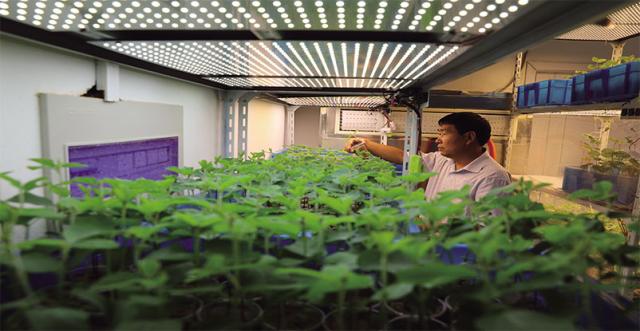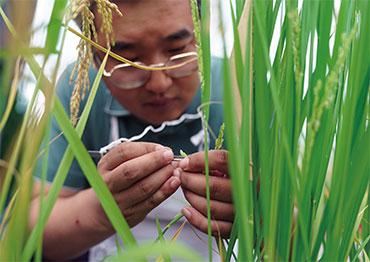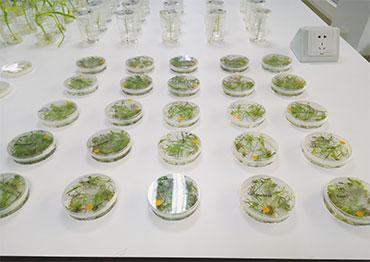This year will be the third Spring Festival in a row Jia Zhiwei has spent working. The deputy-general manager of Longping Biotechnology (Hainan), will shuttle between labs and farms in Sanya, Hainan Province to check on her seeds.
Since the company, a subsidiary of Yuan Long Ping High-Tech Agriculture (Long Ping High-Tech), started in May 2019, Jia and her research team have wintered in Hainan, home to China’s largest southern breeding base, to catch the best season for seed breeding. “It’s a race against time,” Jia said.
The local government developed Yazhou Bay Science and Technology City, a provincial industrial park where Jia’s company is located, to incubate seed and marine science technologies. “The climate in Hainan is ideal for breeding seeds, and the technology city has provided lots of support with laboratory equipment for conducting experiments,” Jia told NewsChina.
This support reflects a change in China’s overall seed industry policy in recent years, which Jia described as “a period of opportunities.” Since 2019, China has emphasized innovation in seed technology as it strives for self-sufficiency for food security amid an increasingly complex global situation.
In February 2021, food security appeared as an independent chapter in China’s official document on agricultural affairs for the first time. A month later, the national 14th FiveYear Plan (2021-2025) put biological breeding as one of the key areas for development to strengthen the country’s strategic position. In July 2021 China approved an action plan for revitalizing the agricultural seed sector, the second in 60 years, which encourages companies to play a larger role in innovation.
Revisions are also being made to the Seed Law to reinforce the protection of new plant varieties and intellectual property (IP) rights.
This has given people in the industry hope, several insiders told NewsChina. However, they call for more market regulation, IP protection and equal access to germplasm resources – living genetic resources, such as seeds or tissues, maintained for breeding, conservation and other research – to cultivate fair competition and enthusiasm among companies.
At the 29th China Beijing Seed Industry Conference held in October 2021, Qiu Huanguang, director of the School of Agricultural Economics and Rural Development at the Renmin University of China, said that China relies heavily on imported soybeans. China’s per unit area yield of corn and soybeans is about 50 percent and 40 percent of that of the US, and their yield ratios are much lower. One important reason is that China lags behind in breeding technologies, Qiu said.
At present, genetically modified (GM) crops like strains of corn, soybean and canola seed are popular in the US, Canada and Brazil, a market dominated by international seed giants like Bayer, Corteva and Syngenta.
Chinese seed giants are working hard to close the gap with developed countries in biotechnology breeding, including transgenic technology and gene editing.
Currently, Longping Biotechnology’s pestresistant and herbicide-tolerant GM corn variety meets national safety standards and is under review for a safety certificate, Jia told NewsChina. Previously, a GM corn variety from Hangzhou Ruifeng Biotech Co Ltd, in which Long Ping High-Tech holds shares, and a GM corn variety and a GM soybean variety from Beijing Dabeinong Technology Group Co Ltd (DBN), a leading animal feed and seed company, were approved in 2019 and 2020. This was a big step toward China’s approval of GM products as staple foods.
“China’s biotech breeding started from zero 20 years ago and is picking up now. It might compete with international seed companies in the future,” Jia said.
Chinese companies are also becoming an innovative force in conventional breeding. The number of seed varieties innovated by companies has increased every year, particularly after China lowered the standard for variety certification in 2017. In 2019, the number of new seed varieties for rice, corn, wheat, cotton and soybeans reached 4,219, a year-on-year rise of 26.5 percent, according to Insight and Info, an industry data provider. Among them, 2,614, or 60.8 percent, were independently or jointly bred by companies, an increase of 608 over 2018, showing that companies received most new variety certifications.
Chinese seed enterprises have come a long way since the planned economic system. Before 1978, farmers usually selected and stored high quality seeds from their farms for the next year. Between 1979 and 2000, the government provided seeds according to region to guarantee yields. During that time, agricultural research institutions were the principal force in seed breeding. After 2000, when the Seed Law was enacted, China broke up regional seed monopolies held by local governments and encouraged research institutions to establish seed companies to spark industry competition.
Data from China industry consultants at askci.com shows that between 1999 and 2018, the market scale of China’s seed industry expanded from 33 billion yuan (US$5.2b) to 120 billion yuan (US$18.8b) to become the second-largest globally.
After market reforms deepened in 2011, private companies entered the seed breeding industry and cooperated with institutions. As of 2019, 97 Chinese companies are licensed to engage in a combination of breeding, reproduction and promotion, according to a report published by the Ministry of Agriculture and Rural Affairs (MARA) in 2020. There were 77 in 2016 and 81 in 2017.
R&D investment of leading companies is also picking up. Long Ping High-Tech, for example, put 10.52 percent of its revenue into R&D in 2020, almost at the level of leading international companies. Its R&D investment kept growing between 2011 and 2019. In 2019, the total R&D investment of companies with annual revenue over US$3.1m reached 360.5 billion yuan (US$56.6b), accounting for 8.12 percent of their seed sales.
The market scale of the seed industry reached 119.2 billion yuan (US$18.7b) in 2019 and is estimated to reach 124.2 billion yuan (US$19.5b) in 2021, according to askci.com. The 2020 MARA report shows more than 6,390 companies licensed for seed breeding and production in 2019, with assets totaling 247.9 billion yuan (US$38.9b). Twenty-three have branches overseas. The global market share of Chinese crop seeds increased from 0.02 percent in 2015 to 1.35 percent in 2019.
Despite the market scale, as several interviewed experts pointed out, concentration of the industry is low, which undermines the sector’s competitiveness and innovation.
Since 2000, the number of seed companies grew dramatically under supportive policies. There were over 8,700 companies around 2010. In 2011, following guidance from the State Council that raised the market entrance threshold, that number almost halved.
Wang Shuqiu, general manager of Beijing Baofeng, a company engaged in maize seed breeding, said the capital requirement for a business license was raised six times, from 5 million yuan (US$784,500) to 30 million yuan (US$4.7m), and her company had struggled to keep its license.
In 2015, the market was streamlined again. The revised Seed Law required that seven pieces of seed information, which helps product traceability, be included in packaging QR codes. “This eliminated many companies that did not operate legally,” Wang said.
By the end of 2017, there were only 5,203 licensed companies, according to askci.com. In 2019, more than 350 companies were valued over 100 million yuan (US$15.7m), 180 more than in 2012. The top 50 companies had over 35 percent of the domestic market, five percentage points higher than 2011, according to MARA.
However, the domestic market share of leading companies remains low and entities with annual turnover of less than 20 million yuan (US$3.1m) make up the bulk of the industry. In 2019, the top five seed companies, including Long Ping High-Tech and Kenfeng Seed, only had 9.6 percent of the domestic market, while the top five international seed giants accounted for 53.1 percent of the global market, according to Forward Intelligence, a Chinese market research provider.
“The strength of Chinese companies is very scattered. They have to fight alone and mostly are weak in R&D,” Wang said. Besides seed giants like Long Ping High-Tech, R&D investment of most Chinese companies is far below that of international competitors.
According to a survey by Li Yuefeng, a member of the Standing Committee of the National People’s Congress involved with drafting the Seed Law, only 1.5 percent of Chinese seed companies have R&D capabilities and the majority spend less than 1 percent of their revenue on R&D compared to around 10 percent for international seed giants, Li said at a conference on the revision of the Seed Law in August.
An industry insider who spoke with NewsChina on condition of anonymity said that it is hard for small- and medium-sized companies to keep investing in innovation. “R&D requires a lot of money and talent. As a small company, we can only rely on market profit to feed research. It usually takes years to produce some effect, and it may not even fit the market. The conversion rate is negligible,” the insider said.
Wang, a 13-year industry veteran, said that after her company started in 2000, it first cooperated with research institutions on new varieties while trying to innovate its own. They collected seeds from farmers and researchers at home and overseas. It took six years to come up with their own varieties. “There weren’t many competitors, so we had time to lay the foundation,” Wang said, adding that today it would be harder for small companies to do the same.
Meanwhile, the homogenization of seed varieties is increasing, Jia said. She noted that germplasm resources for some crops are not rich enough (partly due to lack of identification and appraisal), while research into functional genes lags. “It is common for many companies to make simple modifications based on existing parent materials and produce a new variety or imitative innovation,” Jia told NewsChina.
A DBN employee who asked to remain anonymous agreed that China is weak in biotech breeding innovation compared with developed countries, so fundamental research into some species still lags.
Jia partially blames the lack of breakthroughs in seed breeding on the low requirements for new varieties. In 2014, MARA reformed variety certification standards to spark innovation. However, this led to redundant research. “If all research focuses on the same varieties, innovation will naturally dwindle,” Jia said.
Even though China has approved over 3,700 varieties of rice, corn and wheat, most of the top-five promoted varieties are long established. This shows seed R&D mainly focuses on quantity instead of quality, according to an agricultural development report by the Chinese Academy of Agricultural Sciences in June 2021.
“Making breakthroughs requires long periods of research, which means challenges both for research institutions and companies. It’s harder for the latter if they can’t afford it. So, some research only serves short-term purposes,” said Jia, adding that in other countries where the market is more regulated, companies could profit enough to support long-term research.
“Overall, the lack of motivation to innovate is also because IP protection isn’t strong enough,” said Qu Ping, secretary general of the Beijing Seed Industry Association.
In a video conference on IP rights protection of the seed industry in July 2021, Tang Renjian, minister of MARA, said that in recent years, infringements such as phony varieties and imitations have markedly increased. Between 2016 and 2020, court disputes over new varieties of plants rose from 66 to 252, 80 percent of which involved IP infringement. “Without strong IP rights protection, those who innovate will be taken for a ride,” Tang said.
Wang of Beijing Baofeng told NewsChina that IP infringement has been their biggest headache of the past few years. “As the locations of our breeding bases are included on our packaging, middlemen show up and buy our seeds while posing as farmers (who are legally exempt from paying royalties if for their own use) at a lower price, repackage them, and sell them to farmers for a higher price,” Wang said.
Wang noted that this has squeezed profits at many of Beijing Baofeng’s seed factories. “But it’s difficult to prosecute the violators. Things like this certainly dampen companies’ enthusiasm to innovate,” Wang said.
Jia also voiced concerns over the business environment, calling it the “biggest problem” China’s seed industry faces. For example, despite the crackdown on illegal GM crops, farmers still use unapproved GM corn andsoybean seeds in some regions, particularly in northeastern China. “It might scare some companies out of developing GM products. After all, if they can’t enter a big market like the Northeast, their investment might not yield anything,” Jia said.
“It’s a vicious cycle,” Jia continued. “A market lacking in regulation will result in low profits for companies, which will further affect the building of scientific research systems or mature breeding systems.”
Jia explained that many leading international feed companies record every step of research, so changing hands midway does not hinder progress. But in China, even in big companies, specific breeders control research more. If a key breeder leaves a project, the next breeder might have difficulty getting started immediately.
As governments increasingly promoted the seed industry, insiders noticed changes in financial support and market regulation. Wang told NewsChina that in the last two years, county-level agricultural bureaus have formed task forces to monitor for seeds from illegal channels. “Law enforcement at the grass-roots level picked up in 2021. They go to local points of sale to investigate, get samples and check the packing and plants at the consumer end,” Wang said. “This gives us more hope,” she added.
In August 2021, a draft amendment to the Seed Law was submitted for review to the Standing Committee of the National People’s Congress. It seeks to expand protection for new plant variety rights, saying that producers of derived varieties developed from original varieties for commercial use must first gain consent from the owners of the original varieties. This aims to further stimulate innovation.
Qu Ping stressed the importance of making sure that germplasm resources from the government are accessible to all companies.
“Producing desired varieties first requires rich germplasm resources and then breeding technology. Small- and medium-sized companies could play a large part in breeding, but they require support from the government, such as germplasm resources,” Qu said.
Several interviewed insiders also called for leading research institutions and universities to take on more fundamental research and original innovation.
According to Wang, after 2011, research institutions were encouraged to conduct applied research and enhance cooperation with companies, so fundamental research that could not produce immediate results was neglected.
“Today, many institutions engage in regular breeding for commercial use, and do what companies do instead of doing fundamental research and making original innovations. It might be a waste of resources,” Wang said.
Qu suggested splitting duties: research institutions concentrate on fundamental analysis, exploitation of germplasm resources and making original breakthroughs in key technologies, while companies focus on breeding new varieties. “Profit-driven companies have an advantage in translating research results to the market quickly,” Qu added.
“Companies serve as a bridge between scientific research and market demand. They have the motivation to produce quality seeds, so making companies become the main body of innovation will be the most efficient way to revitalize seed breeding,” Jia told NewsChina. “During the process, the government should not only support research projects but also make efforts to cultivate a benign competition environment, because market forces can feed innovation and help form a virtuous cycle,” Jia said.

 Old Version
Old Version



